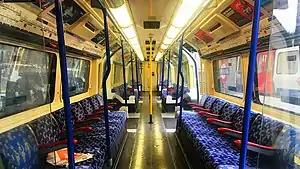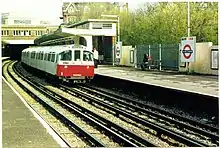London Underground 1973 Stock
The London Underground 1973 Stock is a type of rolling stock used on the Piccadilly line of the London Underground. It was introduced into service in 1975 with the extension of the line to Hatton Cross, followed by a further extension to Heathrow Central in 1977.
| London Underground 1973 Stock | |
|---|---|
.jpg.webp) 1973 Stock passing Turnham Green in 2014 | |
 The refurbished interior of a 1973 Stock | |
| In service | 19 July 1975 – present |
| Manufacturer | Metro-Cammell[1] |
| Built at | Birmingham, England[1] |
| Replaced | 1959 stock |
| Constructed | 1974–1977[1] |
| Refurbished | 1996–2001[1] |
| Formation | 6 cars per train |
| Capacity | 684 per train[1] |
| Line(s) served | Piccadilly |
| Specifications | |
| Train length | 106.810 m (350 ft 5.1 in) |
| Car length | DM 17.473 m (57 ft 3.9 in) UNDM/T 17.676 m (57 ft 11.9 in) |
| Width | 2.629 m (8 ft 7.5 in) |
| Height | 2.888 m (9 ft 5.7 in) |
| Weight | DM 27.15 long tons (27.59 t; 30.41 short tons) UNDM 26.16 long tons (26.58 t; 29.30 short tons) T 18.16 long tons (18.45 t; 20.34 short tons) |
| Traction system | Pneumatic driven camshaft (GEC Traction)[1] |
| Traction motors | LT118 DC motor (Brush Traction)[1] |
| Electric system(s) | 630 V DC Fourth rail |
| Current collection method | Contact shoe |
| Track gauge | 4 ft 8 1⁄2 in (1,435 mm) standard gauge |
| Stock type | Deep-level tube |
The trains were built by Metro-Cammell between 1974 and 1977, and were refurbished by Bombardier Transportation between 1996 and 2001. They are some of the oldest trains running on the Underground, and in Britain as a whole, second only to the 1972 Stock running on the Bakerloo line.
History

In the early 1970s London Transport placed an order for a new fleet of trains to replace the 1959 stock, the 1938 stock and 1962 stock vehicles which previously operated on the Piccadilly line. Built between 1974 and 1977 by Metro Cammell in Birmingham,[2] the first unit entered service on 19 July 1975 and the last was introduced by 1977.[3] The trains featured longer cars and larger door space than the previous units, being designed for airport travellers with luggage.[4]
The order was for 87½ 6-car trains, made up of 196 Driving Motor cars (DM's), 175 Trailer cars (T's) and 154 Uncoupling Non-Driving Motor cars (UNDM's). Each train is made up of two 3-car units, and most units are single-ended, formed DM-T-UNDM. There are also 21 double-ended units, formed DM-T-DM, to provide additional flexibility and to operate the Aldwych shuttle (now closed).[5] The initial order additionally included two test units equipped with solid state traction equipment and electronic control systems. These were double-ended units 892-692-893 (delivered 1977) and 894-694-895 (delivered 1979), and were known collectively as the ETT (Experimental Tube Train). The first unit was equipped by Westinghouse, the second by GEC. In order to provide additional units for the opening of the Heathrow loop, these units were converted to standard at Acton Works, entering service between 1986 and 1987.[5]
One three-car unit (166-566-366) was damaged in a terrorist attack on 7 July 2005 and subsequently scrapped.[6]
Refurbishment
From 1996 to 2001, the entire fleet was refurbished by Bombardier Transportation in Horbury, Wakefield.[7] The interior was completely remodelled, with changes including the removal of transverse seating, replacement of the original wooden flooring with new floor material, replacement of straphangers with new grab rails, new enclosures for the ceiling ventilation fans, brighter lighting with new diffusers, installation of car-end windows and new perch seats in the centre of the cars, creating more luggage space for airport passengers.[8]
The original unpainted exterior was painted in London Underground's corporate livery, and a new emergency detrainment system was fitted in the cabs. The external destination blinds were also replaced with LCDs, and these were subsequently replaced with new LED units in 2015.[9]
The final refurbished unit re-entered service on 10 July 2001.[10]
Future replacement
The Deep tube programme (DTP) originally covered the replacement of the trains and signalling on the Bakerloo and Piccadilly lines, and had been expanded to cover rolling stock requirements arising from the planned extension of the Northern line to Battersea, the eventual replacement of Central line trains, and proposed increased service frequency on the Northern and Jubilee lines. The EVO tube concept design, a lighter articulated train with walk-through cars, was introduced early in 2011.[11] In early 2014 the Bakerloo, Piccadilly, Central and Waterloo & City line rolling stock replacement project was renamed New Tube for London (NTfL) and moved from its feasibility stage to the design and specification stage.[12][13] The proposal introduces fully automated trains and signalling to increase capacity first on the Piccadilly line in 2025, followed the Central, Waterloo & City, and Bakerloo lines by 2033. The fully automated trains may not have drivers,[14] however the ASLEF and RMT trade unions that represent the drivers strongly oppose this, saying it would be unsafe.[15]
In June 2018, TfL announced 94 six-car 2024 stock trains are to replace the 1973 Stock from 2023.[16] This has since slipped to 2025.[17]
References
- Neil, Graham. "London Underground Rolling Stock Information Sheet" (PDF). WhatDoTheyKnow. Retrieved 17 April 2016.
- "Piccadilly line facts". Transport for London. Archived from the original on 10 February 2014. Retrieved 13 August 2012.
- "London Underground 1973 Tube Stock". TrainWeb. Retrieved 13 August 2012.
- "1973 tube stock". Square Wheels. 8 November 2010. Retrieved 13 August 2012.
- http://www.trainweb.org/tubeprune/73%20tube%20stock.htm
- https://www.londonbanter.co.uk/london-transport/3944-july-bombing-train-returned-service.html
- "New Look Trains on the Piccadilly Line". London Transport. 17 June 1996. Archived from the original on 11 January 1997. Retrieved 27 May 2020.
- Griffin, Richard. "SQUAREWHEELS.org.uk - 1973 tube stock". www.squarewheels.org.uk. Retrieved 15 April 2017.
- http://districtdavesforum.co.uk/thread/24821/new-displays-on-73s
- Griffin, Richard. "SQUAREWHEELS.org.uk - 1973 tube stock". www.squarewheels.org.uk. Retrieved 15 April 2017.
- Connor, Piers (January 2013). "Deep tube transformation". Modern Railways. pp. 44–47.
- "New Tube for London Programme" (PDF). Board Minutes. Transport for London. 5 February 2014. Retrieved 3 April 2014.
- "New Tube for London Programme". Railway Gazette. 28 February 2014. Retrieved 3 April 2014.
- "TfL prepares for driverless tube". Railnews. 28 February 2014. Retrieved 3 April 2014.
- "Driverless Tube trains: Unions vow 'war' over plan". BBC News. 28 February 2014. Retrieved 3 April 2014.
- Siemens to supply London Underground deep tube fleet Metro Report International 15 June 2018
- 2024 Stock design due soon Rail Express issue 207 February 2021 page 43
External links
| Wikimedia Commons has media related to London Underground 1973 Stock. |